Cosmic ‘murder mystery’ solved after 37 years: NASA’s James Webb finds evidence of a neutron star left by a supernova 160,000 light-years from Earth
After 37 years, scientists have finally solved a cosmic ‘murder mystery’ that even Poirot or Miss Marple would have struggled with.
And unraveling what happened to this ‘superstar’ victim took more than asking the butler a few pointed questions.
In 1987, scientists watched as a star 160,000 light-years from Earth exploded in the brightest supernova in 400 years.
What the cataclysmic Supernova 1987A left behind has been hidden beneath thick clouds of dust ever since.
But now an international team of scientists have used the James Webb telescope to find evidence of a neutron star left behind by the explosion.
Scientists have solved a 37-year-old cosmic ‘murder mystery’ as they reveal what was left behind after the explosion of Supernova 1987A (pictured)
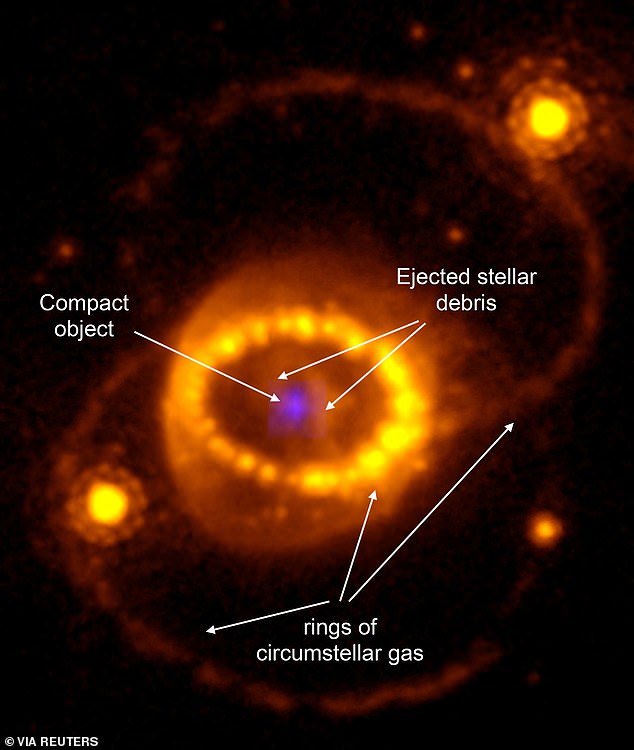
An international team of researchers has found evidence of a neutron star at the heart of the supernova material. A compact object was known to be there (pictured), but it had remained hidden behind clouds of debris
Supernovae are caused by the collapse of stars between eight and ten times the mass of our Sun.
As these massive stars collapse in on themselves, the surface is pulled inward so quickly that they create powerful shock waves that cause the outer layers to explode.
The explosions are the origin of all the carbon, oxygen, silicon and iron that are essential for the development of life.
Occasionally these deaths leave behind a core of incredibly hot and dense material, which can form a black hole if the star is large enough.
Typically, this leaves behind a neutron star, an object no more than 20 km in diameter and composed largely of subatomic particles called neutrons.
Neutron stars are so compact that a sugar cube of neutron star material on Earth would weigh a billion tons – about the same as a mountain.
In February 1987, scientists saw a supernova in the Large Magellanic Cloud, a neighboring dwarf galaxy, burning with the intensity of 100 suns.
Supernova 1987A was so bright that it could be seen from Earth for months and was even visible to the naked eye.
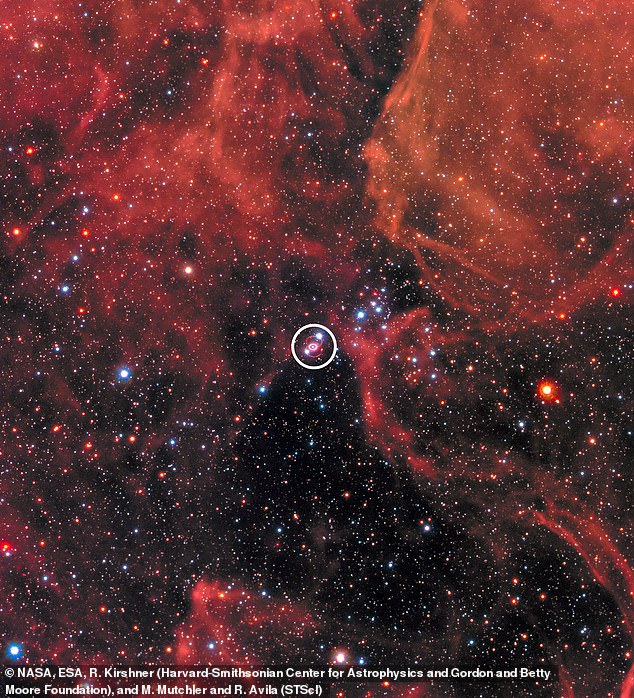
Supernova 1987A was the brightest supernova visible from Earth for more than 400 years. Located in the Large Magellanic Cloud (pictured), a neighboring galaxy, it was so bright that it was even visible to the naked eye
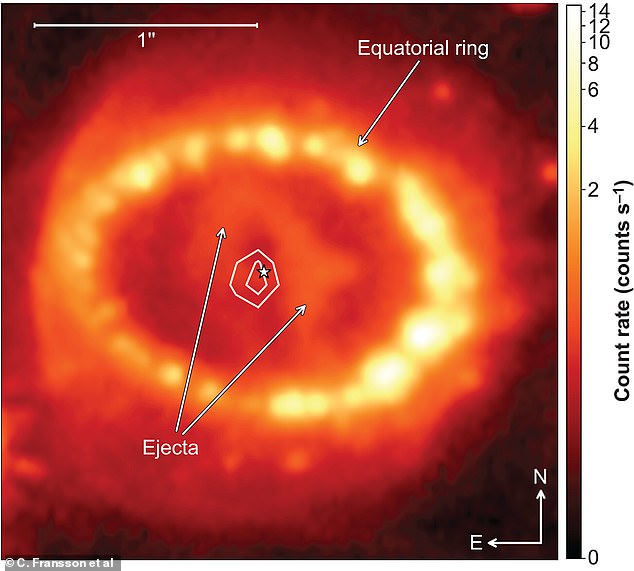
This earlier photo taken by the Hubble Space Telescope shows the ring of hotter material (in white) surrounding a core hidden by dust
Scientists had long suspected that a neutron star was left behind by the explosion, but so much dust was left behind that even the most powerful telescopes could not confirm it.
But now a team of researchers say they have found the first evidence that a neutron star is lurking in the rubble.
BBC sky at night presenter Dr Maggie Aderin-Pocock said the investigation team had ‘solved a murder mystery’.
She added: “It’s about the death of a star and the mystery is what lies in the dust clouds surrounding what remains.”
Using two instruments aboard the James Webb Space Telescope (JWST), a team of scientists looked at the infrared wavelengths of light coming from the supernova’s region
They discovered that there were heavy argon and sulfur atoms with their outermost electrons removed.
By modeling how these atoms could have gotten there, the researchers discovered that they could only have been created by a neutron star.
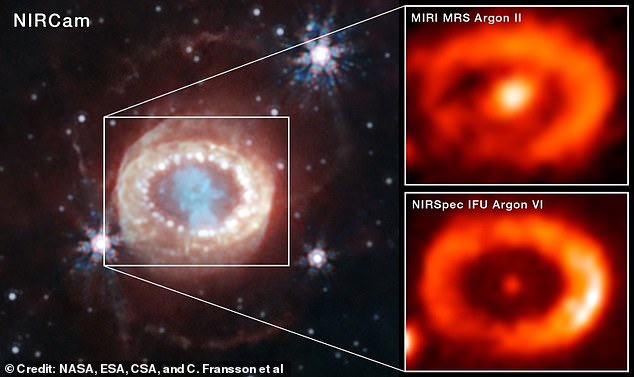
Researchers used the James Webb Space Telescope to look at the infrared radiation emitted by the ejected material. They discovered the presence of argon (photo) and sulfur atoms that had been stripped of their outer electrons
Professor Mike Barlow, an astronomer from UCL and co-author of the study, said: ‘Our data can only be fitted with a neutron star as a power source for that ionizing radiation.’
The researchers have two theories about how this could have come about.
Professor Barlow explained: ‘This radiation could be emitted by the million-degree surface of the hot neutron star, but also by a pulsar wind nebula that could have been created as the neutron star rotates rapidly, dragging charged particles around it.’
As neutron stars collapse in on themselves, they heat up to billions of degrees at the surface.
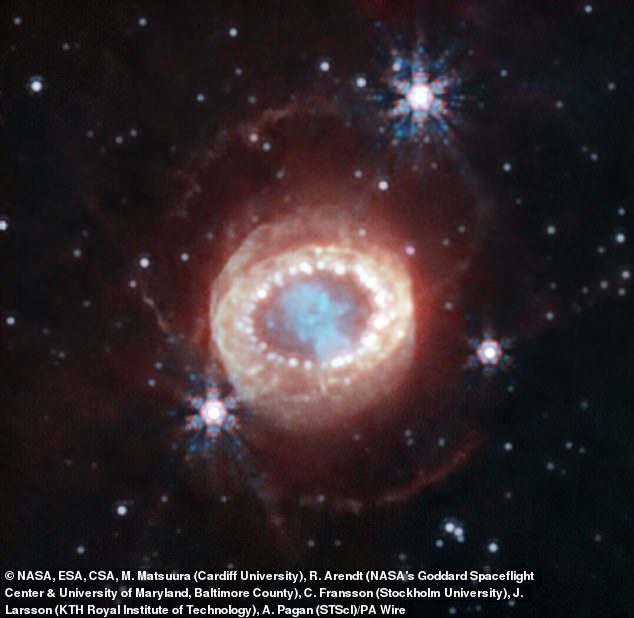
The researchers believe that the argon and sulfur atoms could only have been stripped of their electrons by a neutron star hidden in the center of Supernova 1987A (photo).
As they cool, this energy is sent out into the universe in the form of enormous amounts of ultraviolet and X-rays.
But as a neutron star spins, it will actually drag around it ‘winds’ of relativistic particles that can interact with the surrounding supernova material.
An example of this kind of force can be seen in the Crab Nebula, the remnant of a supernova observed by Chinese astronomers in 1054.
In both cases, scientists now have a strong indication that a neutron star must be present.
Professor Barlow added: ‘The mystery of whether a neutron star is hiding in dust has been going on for more than thirty years and it is exciting that we have solved it.’
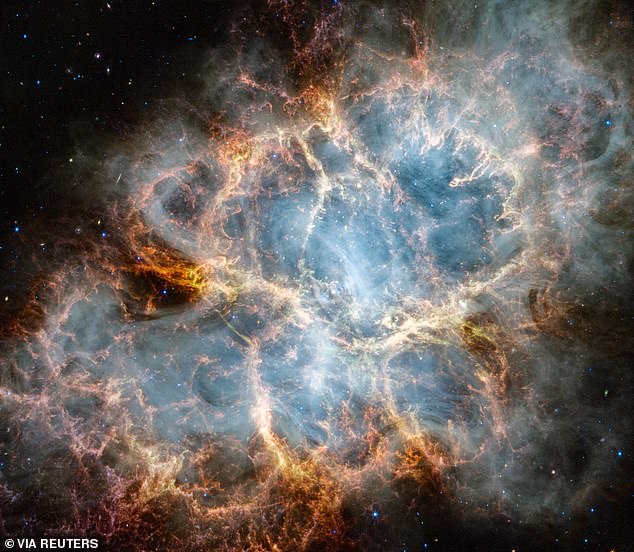
The Crab Nebula (pictured) is a good example of how a spinning neutron star can create a ‘wind’ of particles that interact with material from the supernova
Lead author of the paper, Professor Claes Fransson from Stockholm University, said: ‘Thanks to the excellent spatial resolution and excellent instruments at JWST, we have been able to investigate the center of the supernova and what formed there for the first time.’
Scientists had suspected that a neutron star might be present because on February 23, 1987, scientists detected a pulse of neutrinos passing through Earth.
These fast-moving, weakly interacting particles reached Earth a day before the supernova was first seen and possibly indicated that a neutron star had formed.
This was the first supernova to be detected for its neutrinos, which make up 99.9 percent of all the energy emitted during the explosion.
Although a huge amount of neutrinos were emitted, three detectors on Earth only managed to capture about twenty as they passed.
Professor Fransson added that scientists had long thought a neutron star was responsible for this pulse, but that they “had to wait until JWST could verify the predictions.”
